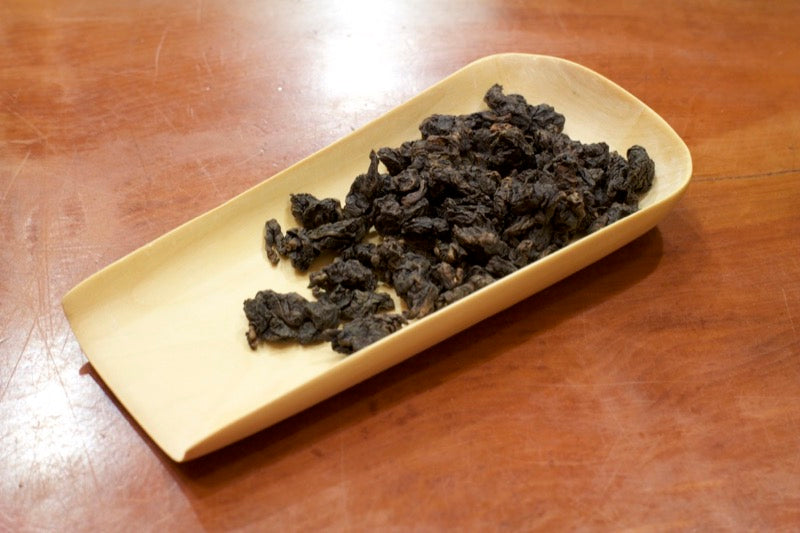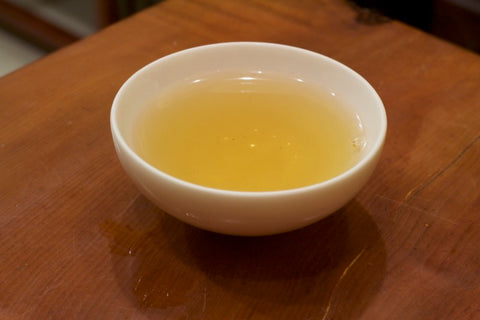Tea review: Bai Ya Qi Lan – White bud orchid
Fujian province is one of the main tea production areas of China. The north of the province is the cradle of the most famous Chinese white teas (Yin Zhen, Bai Mu Dan), of the outstanding Minhong Gongfu –superior black teas– and of Wuyi Rock Tea –an Oolong tea grown in a Unesco world heritage site. In the South, the floral Tieguanyin is largely cultivated: an icon among the “green” oolongs.
Driven by market dynamics, all these teas are overpriced, up to the extreme. A status symbol for rich Chinese, willing to pay a fortune for 100g of the best Rock tea or Tieguanyin without even being able to thoroughly appreciate them.

Tea & wealth in China: Bentley and Mercedes S500 in front of a Pu'er tea shop in Kunming: do the cars belong to the shopkeeper or to customers?
Bai Ya Qi Lan did not yet attract the wallets of the wealthy upper society, probably too similar, at the first glance, to its closest neighbor: Tieguanyin.
Bai Ya Qi Lan is a “green” oolong, where “green” refers to the low level of oxidation of the leaves. It is grown in the Pinghe area, in the southernmost corner of Fujian province. Subtropical monsoon climate, mild temperature, abundant rain and fertile soil favor tea cultivation.
The appearance is similar to Tieguanyin: rolled greenish leaves.

Dry leaves of Bai Ya Qi Lan. Medium roasted.
The taste, however, is unique. Very floral, but not as sweet and nauseous as sometimes Tieguanyin can be. The leaves are properly oxidized, with no traces of the grassy taste common to Tieguanyin, for which the oxidation is carried out in air-conditioned rooms to maximize freshness and aroma, to the detriment of mouthfeel, body and complexity of taste.
Fujian province, early January 2016
After a first screening, some tea friends and I choose three Bai Ya Qi Lan for a parallel tea tasting. We taste them blind, without knowing which tea will go into which cup. We don’t want to be influenced in our judgment by the different prices and sources.

Blind parallel tea tasting of three Bai Ya Qi Lan
The third tea is too heavily roasted. After the first sip, we all agree that the charcoal taste is too intense, covering completely the intrinsic aroma of the leaves. The first two teas are similar to each other. We steep them several times and only at the end share our thoughts. Despite the similarity, the three of us all vote for the second: slightly more roasted and therefore of thicker texture, but at the same time very mellow and aromatic. And, surprisingly, it costs even less than the first tea! This is the tea I will order for nannuoshan!
NOTE: The price of a tea is often driven by the harvest time, more expensive tea being picked earlier in the season. The taste, however, depends strongly on weather conditions at the harvest day and processing.


Steeped unfolding leaves in the gaiwan and Bay Ya Qi Lan in the cup.
The return of sweet
A sip of Bai Ya Qi Lan fills the mouth with a velvety floral sweetness; addictive, I would say. But it’s the return of sweetness the excite me most. One indulges to take another sip to enjoy the aftertaste a bit longer; an intense sweet sensation that comes back from the throat to delight once again the taste buds. Even hours after the last cup the sweetness, from time to time, comes back into the mount. Tieguanyin can also be so intense, but certainly not for the same price!
Written by Gabriele

